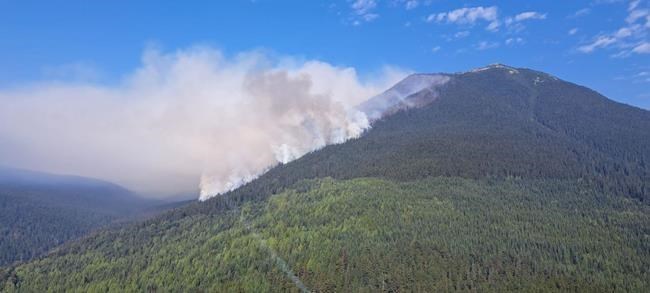
British Columbia's wildfire service says southern parts of the province are benefiting from rain and cooler weather, a reprieve for the southeast in particular. The eastern flank of a fire designated R32019 by the B.C. Wildfire Service is seen near Seaton, B.C., in a Sunday, Aug. 18, 2024, handout photo. THE CANADIAN PRESS/HO-BC Wildfire Service, *MANDATORY CREDIT*
Republished August 19, 2024 - 6:22 PM
Original Publication Date August 19, 2024 - 12:01 PM
Brian Dack says wildfires have come close to the Kluane Wilderness Lodge in southwestern Yukon before, but none have been so large and fast-moving as the blaze that's currently threatening his business of more than two decades.
The fishing lodge on the shores of Wellesley Lake is accessible only by flying in, and it's now the site of helicopter evacuations as the fire bears down on the lodge and its cabins after gusty winds whipped up the flames and smoke on Sunday.
The Yukon government said Monday that three cabins were destroyed after Sunday's "extreme fire behaviour," but cooler tempertature and humidity tamed the blaze and "it has not moved significantly since last night."
"However, it is still creating a lot of smoke." "It was absolutely incredible. I've never seen nothing like it before," Dack said in an interview on Monday. "It's burnt all the way down the lake on the west side and it's about halfway down the lake on the east side."
Dack said winds were gusting up to 40 kilometres per hour.
"Hopefully it'll blow at the right direction, but right now it's not," he said.
Still, Dack said he's staying put with some staff at the lodge for now as wildfire crews set up structural protection sprinklers.
"We'll set up more sprinklers around here and hope for the best," he said. "But right now there's not much we can do."
Dack said there would be a loss of revenue for the lodge for the rest of the summer due to the wildfire.
The out-of-control blaze was first reported in June and had grown to span more than 20 square kilometres as of Monday.
The Yukon government's wildfire information website said the Snag Lake fire displayed "extreme behaviour" in hot and dry conditions the day before.
It said fire officials were at the site and four people had been evacuated by helicopter, with further evacuations planned.
Dack said the those who left the lodge were a family from Northern California who were "very understanding" about the evacuation.
"I think they're kind of used to smoke," Dack said, adding the family told him they would return to the lodge next year.
Dack said the heat in the region has been "unbearable" at times this summer, and he's noticed dry conditions on his forest walks.
"The moss, it just scrunches when you walk on it," he said. "I mean, our hottest day here this year was 42 degrees, which is just unheard of for the North."
Dack said he can only hope that the area will see enough snow over the winter to snuff out the wildfire completely.
"But it's just been so hot and dry and hardly any rain throughout the summer," he said.
"We'll just have to wait and see."
The Snag Lake wildfire is burning about 15 kilometres east of the Snag Junction area along the Alaska Highway. Smoke from the fire is visible, but the highway and buildings along the route are not currently at risk, the government website said.
British Columbia's wildfire service, meanwhile, said areas in the south were benefiting from rain and cooler weather, a reprieve for the southeast in particular.
But a bulletin from the service on Monday said there's a drying trend in the north and unfavourable winds could fan increased fire behaviour, especially in the northwest.
About 370 wildfires are active across B.C., with 34 per cent burning out of control, down from about 40 per cent in recent days.
Five blazes are considered "wildfires of note," meaning they are highly visible or pose a threat to public safety or infrastructure, though the BC Wildfire Service said three are classified as "being held" within their current or predetermined perimeters.
This report by The Canadian Press was first published Aug. 19, 2024.
News from © The Canadian Press, 2024